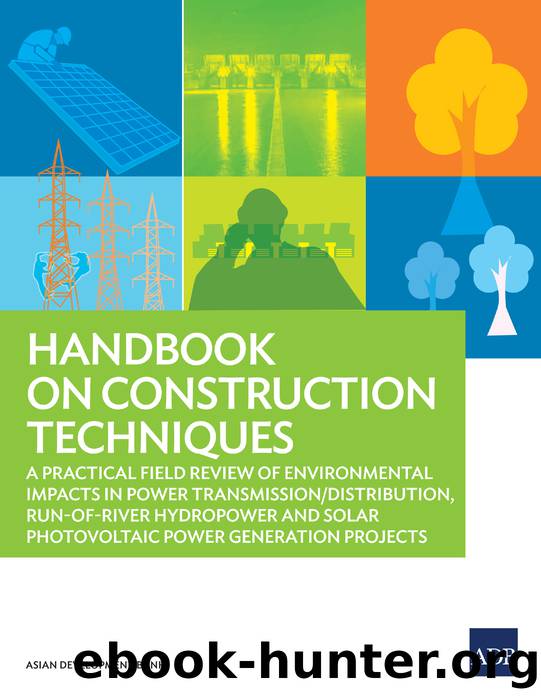Handbook on Construction Techniques by Sasaki Shotaro;Jain Rajat;

Author:Sasaki, Shotaro;Jain, Rajat;
Language: eng
Format: epub
Publisher: Asian Development Bank Institute
Published: 2016-09-15T00:00:00+00:00
Source: HPPCL Documents for Sawra Kuddu HEP (111 MW) â an ADB funded project
58. Surface Project Activities
⢠Barrage and/or trench weir (in place of barrage in medium size projects)
⢠Other civil works (on-ground) in the project area includes:
Dumping areas.
Resettlement areas.
Development of portals for working, equipment.
Camps, offices, workshops etc.
Access roads, highway.
Temporary bridges.
Buildings.
Development of quarry for construction material.
59. Electro Mechanical Works: The hydropower project contains several electrical mechanical equipment such as the generator (See Glossary 48), the stator (See Glossary 113) and the turbines (See Glossary 127). Besides there, there are several mechanical equipment used in the hydropower projects such as gates of various types: diversion tunnel gates, barrage and sluice gates, barrage bay and sluice bay stop logs, trash racks (See Glossary 126) and trash cleaning machine, intake gates, sedimentation chamber gates, flushing conduit gates, emergency valves, main inlet valves, draft tube gates, outlet gates, and access doors.
60. The ROR hydropower projects usually generate electricity at 11/33 kV voltages and then step up to 132 kV or 220 kV in the switchyard substation using a step up transformer. The power evacuation lines emanate from the switchyardâs terminating gantry and then travel to a pooling substation where the power generation from other generators is pooled to interstate power evacuation lines after another step-up to 400 or 765 kV.
61. The Flow Chart in Figure 10 displays activities as they progress while constructing a hydropower generation project. On the left are the âStepsâ involved in the process of project implementation such as âPre Construction, Facilities Setup, Construction, Erection, and Commissioningâ. The âTasksâ performed are numbered in a sequential manner i.e. 1-17 (as shown by arrows). Some âTasksâ are grouped together in a particular âStepâ in the order of their occurrence in a project cycle. Their placement (i.e. 1&3, 2&4) has no particular significance. For example, The construction related environmental impacts usually occur during implementation of âTasksâ 2-17. These âTasksâ are usually performed by the Engineering Procurement and Construction (EPC) contractor.
Figure 10: Process Flow Chart for Construction of Hydropower project
Download
This site does not store any files on its server. We only index and link to content provided by other sites. Please contact the content providers to delete copyright contents if any and email us, we'll remove relevant links or contents immediately.
| Automotive | Engineering |
| Transportation |
Whiskies Galore by Ian Buxton(41525)
Introduction to Aircraft Design (Cambridge Aerospace Series) by John P. Fielding(32885)
Small Unmanned Fixed-wing Aircraft Design by Andrew J. Keane Andras Sobester James P. Scanlan & András Sóbester & James P. Scanlan(32569)
Craft Beer for the Homebrewer by Michael Agnew(17928)
Turbulence by E. J. Noyes(7694)
The Complete Stick Figure Physics Tutorials by Allen Sarah(7135)
Kaplan MCAT General Chemistry Review by Kaplan(6591)
The Thirst by Nesbo Jo(6432)
Bad Blood by John Carreyrou(6271)
Modelling of Convective Heat and Mass Transfer in Rotating Flows by Igor V. Shevchuk(6219)
Learning SQL by Alan Beaulieu(6029)
Weapons of Math Destruction by Cathy O'Neil(5824)
Man-made Catastrophes and Risk Information Concealment by Dmitry Chernov & Didier Sornette(5643)
Digital Minimalism by Cal Newport;(5388)
Life 3.0: Being Human in the Age of Artificial Intelligence by Tegmark Max(5182)
iGen by Jean M. Twenge(5158)
Secrets of Antigravity Propulsion: Tesla, UFOs, and Classified Aerospace Technology by Ph.D. Paul A. Laviolette(4980)
Design of Trajectory Optimization Approach for Space Maneuver Vehicle Skip Entry Problems by Runqi Chai & Al Savvaris & Antonios Tsourdos & Senchun Chai(4837)
Electronic Devices & Circuits by Jacob Millman & Christos C. Halkias(4741)
